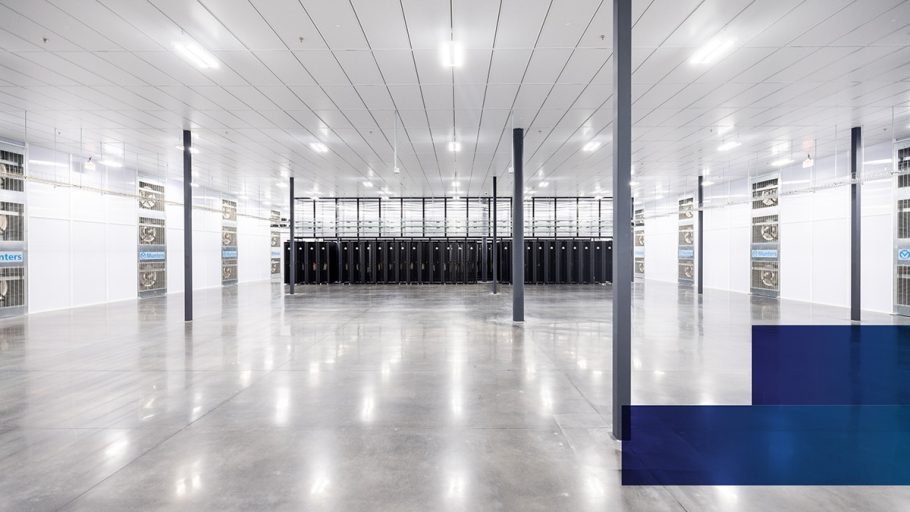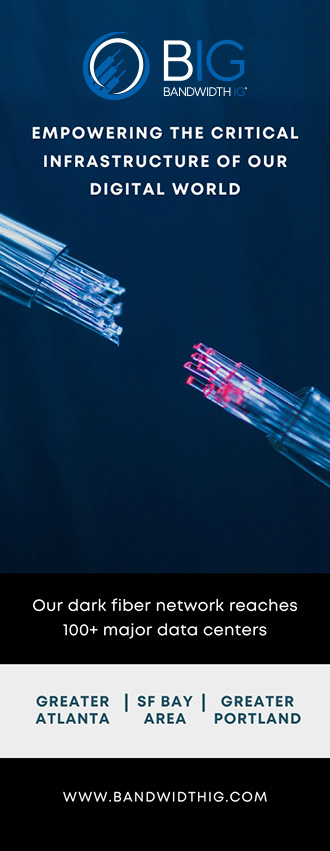Over the recent decades, the technological wave initiated by the advent of the Internet was predominantly focused on digital connectivity. This foundation revolutionized how people connect, communicate, and conduct commerce. As we progress into 2024, digital connectivity makes it possible to set the stage for the next transformational era marked by deeper technological integration between technology and humans. The current technological surge extends digital connectivity into human-machine interactions, pushing capabilities beyond traditional boundaries.
In today’s digital world, computers are performing the work of cognition, creation, communication, optimization, perception, prediction, and automation. Machines can even blend physical and virtual worlds. Powered by the enduring framework of digital connectivity, these advanced forms of computing will transform our lives at a previously unimaginable pace when compared to what was possible with classical compute models.
Data centers enable all digital technology, from supporting the computational power and network requirements of AI to exploring new realms of spatial computing in augmented and virtual reality and opening the door to a full spectrum of next-generation advancements.
Navigating the New Digital Frontier with the Generative AI and Large Language Models Revolution
In the wake of Generative AI (GenAI)’s entrance into the mainstream last year, it’s only natural that 2024 will unveil AI’s transformative impact on business applications. Fortified by the limitless potential of Large Language Models (LLMs), AI technologies are a powerful multiplier for human ambitions. LLMs elevate the role of machines from passive tools to active assistants and advisors capable of working in virtually every operational activity and across all industries.
For companies that may have hesitated during the early stages of digital transformation, 2024 presents a golden opportunity to place AI squarely at the center of operational models. AI tools can understand and respond to natural language with increasing accuracy, compose music and generate art, identify human emotions, analyze systems in a continuous learning loop, power robotics, and solve problems by adapting to new data sets. As AI technology continues to evolve, it is creating new business opportunities.

The Cost Conundrum, Low Latency AI Solutions, and Navigating AI System Scaling
To utilize the full potential of GenAI and its technological counterparts, experimenting or merely treading water will be insufficient. Taking strategic steps to prepare for AI implementation includes preparing the data center foundation and network required to drive AI success.
While the potential of AI is exhilarating, the data center industry has seen firsthand the undeniably high costs of supporting GenAI deployments. LLMs like Bard and GPT-4 rely on massive training data sets to achieve sophisticated AI results. The electricity required to power a single day of ChatGPT usage is equivalent to the power consumption of 33,000 US households. The global appetite for computational power is devouring resources, and an already diminished supply of hardware to run programs further restrains utility power.
Operating mega AI models will necessitate an evolution of AI architecture, welcoming a far better energy consumption payoff with flexible, less resource-intensive models that utilize smaller data sets for specific learning tasks and domain-specific results. The advent of AI model optionality enables compact but still mighty AI problem-solving capabilities that can democratize AI for wider business and localized adoption.
As businesses further integrate AI, a spectrum of requirements like scalability, training time, privacy, and latency will likely emerge based on specific applications. For instance, while AI-based customer service applications can tolerate delays, applications designed for intelligent traffic management can’t tolerate delays, as every millisecond is the difference between life and death. Latency-sensitive AI systems will demand robust network infrastructure tailored for high-speed, mission-critical response times, which highlights the relevance of network and infrastructural readiness for real-time AI solutions.
The evolution of nimble AI models will spur continued investment in edge computing infrastructure and high-bandwidth networks, thereby ensuring seamless data flow across storage and processing units. Such investments are critical for linking edge sites with central data centers or cloud platforms to ensure efficient data accessibility for AI applications.

Exploring The Synergy of Spatial Computing in Redefining Human-Machine Interaction
Spatial computing, while not a new development, has been steadily evolving. The convergence of AI’s advanced learning and predictive capabilities may, in fact, supercharge advances in spatial computing and hasten the growing realism of these tools, thereby transforming the science fiction-like interactions between humans and machines into tangible reality.
Supported by augmented reality (AR) and virtual reality (VR), spatial computing merges data, logic, and three-dimensional contextual information to create interactive environments. In these environments, humans can manipulate digital objects in spatial content and directly influence the digital process to change the elements as naturally as we do with physical objects in the real world. The implications for industries are profound. For example, surgeons can perform precision operations, guided by holographic data and real-time imaging overlays, to improve patient outcomes.
Likewise, manufacturing teams designing and testing products can collaborate within virtual environments and drastically reduce development time and cost.
The next wave of spatial computing devices integrates AI, AR, and VR to foster deeply immersive interactions with computing environments. As these technologies become more widespread, the demand for advanced digital infrastructure to support rapid data processing and instantaneous network requirements will increase. Data centers with resilient, high-performance network infrastructure will be crucial for the adoption and scalability of these technologies, which enable synchronized and high-fidelity interactions that will drive the future of digital and physical world convergence.
Harnessing the Edge: The Keystone of Next-Generation Technologies
Edge computing has proven its value by remaining a stalwart leader in the tech arena. In 2024, with seamless human-computer integration, AI’s rapid evolution, and spatial computing’s immersive experiences, the strategic importance of edge computing is unmistakably clear. The technology that will reshape the digital landscape, altering the way we live and work, needs a robust data center strategy that embraces the edge.
We are in an age of ubiquitous connectivity. The importance of immediate computational responses underpins all these technologies. Edge computing tackles these requirements by decentralizing data processing and placing computational resources closer to data generation or response sources to address the latency, bandwidth, regulatory, and privacy challenges inherent in AI or spatial computing.
As electronic data exchanges expand globally, businesses face the challenge of adapting to the intricacies of digital economies, which encompass diverse partners and geographical regions. The vast computational needs of GenAI models will require investments in edge nodes between cloud installations and applications that demand instantaneous responsiveness. For example, smart industrial automation will need to train AI models and run inference where the data is created, which will result in more resources moving to the edge of networks to deliver AI results.
In the context of spatial computing, edge digital infrastructure facilitates instantaneous data synchronization between physical and virtual realms, ensuring 3D models accurately reflect and overlay with their physical counterparts in real time.
Edge computing infrastructure is not just a technical necessity; it represents a strategic business decision that is part of the digital transformation journey and supports the performance of various technologies or applications. Interconnection data centers empower this shift by supporting requirements like providing localized experiences (proximity), delivering the highest data volumes with the lowest latency (time), enhancing data velocity and network architecture (performance), and enabling access to dense clusters of network and cloud providers (connectivity).
Network interconnection is the inevitable solution to support accessible and scalable next-generation technologies. An automated edge-to-cloud digital infrastructure is the cornerstone upon which businesses reimagine products, collaborate with partners, and reshape distribution and engagement.

Sustainability and Energy Efficiency: A Moral and Business Imperative
The frontier of AI and emerging technologies presents noteworthy challenges for the data center industry, including unprecedented demand on energy resources. The enthusiasm for AI’s innovative potential brings us to a critical juncture where our drive for innovation must not sideline the imperative ideals of sustainability.
Data centers, being platforms for technology, serve as a crucial lens for sustainable technological advancement as the race to reduce environmental impact meets skyrocketing data demands and unparalleled energy usage. The interest in technologies like AI, cryptocurrency mining, and IoT places substantial burdens on energy resources.
Our industry’s commitment to balance sustainable and technological progress is more than a moral obligation—it is our business imperative. In 2024, we anticipate the emergence of novel carbon capture and storage solutions, renewable energy technologies, and energy reduction measures. Pressure to act may be further incentivized. A report by Gartner predicts that by 2027, 25 percent of CIOs will have their compensation linked to the impact of sustainable technology. Contemporary expectations and regulations emphasize sustainability, which compels organizations to integrate sustainable practices into their business strategies.
In a recent milestone, Netrality Data Centers, the largest privately held owner and operator of core interconnection facilities in the US, secured a 380 million USD sustainability-linked loan (SLL). The SLL will fuel data center expansion projects that embody sustainable designs and implement infrastructural measures to support reducing power usage effectiveness (PUE) levels across Netrality’s portfolio. The recent sustainability-linked financing expands Netrality’s ability to deliver always-on connectivity for latency-sensitive, mission-critical businesses within an environmentally conscious framework.
With this commitment to sustainability, Netrality Data Centers joins industry innovators in embracing a future where technology and environmental responsibility go hand in hand.
Embracing Innovation and the Pivotal Role of Data Centers in 2024’s Digital Economy
We are witnessing the maturing of a digital economy, where innovative tech solutions redefine how value is created and delivered. As digital infrastructure providers, our role is clear: agility and innovation. They are essential to power the next wave of technological breakthroughs. By integrating sustainability into the core of our operations, we can foster a technological ecosystem that balances the scale between groundbreaking advancements and environmental stewardship. The data center industry is not just a part of the digital transformation; it is its beating heart. Our collective vision will shape what comes next and unlock unprecedented possibilities for technology and business leaders alike.
ABOUT THE AUTHOR
Amber Caramella is the Chief Revenue Officer at Netrality Data Centers. With more than 20 years of sales and leadership experience in the digital infrastructure industry, Caramella is responsible for Netrality’s revenue generation strategy and execution, where she oversees sales, marketing, interconnection, network solutions, strategic alliances, and channel partnerships. Prior to joining Netrality, she served as SVP of Sales at Zayo, where she built the company’s global cloud, software, infrastructure, and data center vertical segment.
Caramella is on Bluebird Network’s Board of Directors, Cato Digital’s Board of Directors, and Infrastructure Masons’ Advisory Council. She also serves as iM Women’s Global Executive Sponsor and is part of the Inclusion Committee, working to raise awareness and education for underrepresented groups. Caramella’s goal is to increase the visibility and career advancement of women by transforming industry culture and ideology, leading to the development of a diverse pipeline for future industry talent.



